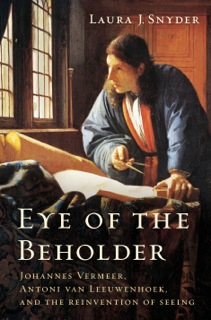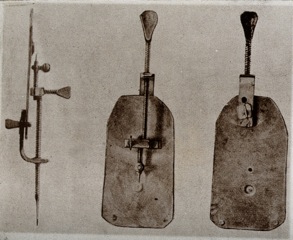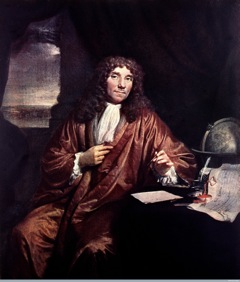By Laura J. Snyder (Guest Contributor)
Are they really alive? Antoni Leeuwenhoek was stupefied.
It was a bright day in the summer of 1674, and Leeuwenhoek was sitting in his study in the small Dutch town of Delft. A cloth salesman turned microscope maker, Leeuwenhoek had closed up the shutters, leaving only a small hole through which a beam of light entered the room. He picked up one of his devices: a brass oblong about two and a half inches long and one inch wide, with a tiny bead of glass in its center. Attached to the back of the device was a glass tube the width of a human hair. Leeuwenhoek filled the tube with a drop of water taken from the Berkelse Mere, a lake two hours by foot from Delft.
Lifting the microscope to his eye Leeuwenhoek peered upwards into the light, as if looking at the stars through a telescope. He gazed at the water in the tube, focusing the device by turning this way and that a tiny screw attached to it. Perhaps he was expecting to see tiny “globules” in the water, like those he had recently observed in his own blood. Minuscule shadows began to come into view. Leeuwenhoek continued to focus the device. Then, suddenly, something appeared that was so incredible his hands began to shake, nearly spilling the water in the tube.
He rested the microscope on the desk for a moment, took a deep breath, and began again. His eyes were not deceiving him. They saw not tiny globules, but particles of different shapes—round, oval, snake-like—some larger and other smaller. Most fantastically, these shapes were moving themselves by means of minuscule fins and legs and wings. They were living creatures! As Leeuwenhoek later related to the Royal Society of London, “the motion of these little animals in the water was so swift, and so various, downwards, and round about, that I confess I could not but wonder at it.”
Leeuwenhoek had just discovered microscopic life. For the first time, someone realized that there was a world of tiny creatures invisible to naked vision—that in the universe there was more than meets the eye. This discovery would transform biology, anatomy, medicine, even, eventually, Delft’s brewing industry, in the period we call the “scientific revolution.”
Leeuwenhoek was not the only genius working with lenses in Delft. At the same time, across the Market Square, a man born the same week as Leeuwenhoek was also using lenses and optical devices to see what no one else had seen before. The artist Johannes Vermeer was making his own optical experiments to understand how light works to help us see, and to paint the most luminous works ever beheld.
Eye of the Beholder tells the story of the intersecting lives of Leeuwenhoek and Vermeer, and the remarkable transformation they wrought in how we see the world—a transformation that lives with us today.
 Laura J. Snyder is a Fulbright scholar and the author of Eye of the Beholder: Johannes Vermeer, Antoni Van Leeuwenhoek, and the Reinvention of Seeing. Her previous book, The Philosophical Breakfast Club, was a Scientific American Notable Book, winner of the 2011 Royal Institution of Australia poll for Favorite Science Book, and an official selection of the TED Book Club. To learn more about Laura and her books see laurajsnyder.com.
Laura J. Snyder is a Fulbright scholar and the author of Eye of the Beholder: Johannes Vermeer, Antoni Van Leeuwenhoek, and the Reinvention of Seeing. Her previous book, The Philosophical Breakfast Club, was a Scientific American Notable Book, winner of the 2011 Royal Institution of Australia poll for Favorite Science Book, and an official selection of the TED Book Club. To learn more about Laura and her books see laurajsnyder.com.


